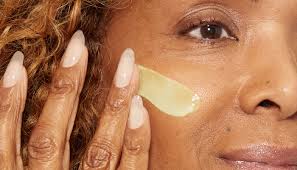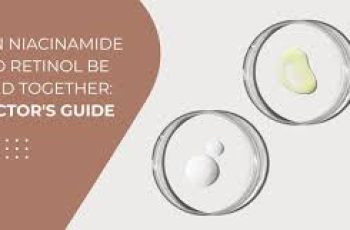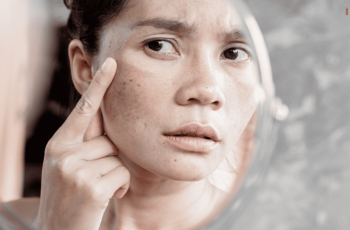.webp)
.webp)
.webp)
.webp)
Can You Use Retinol Cream Under Eyes?
.webp)
.webp)
Yes, you can use retinol under the eyes. But it’s important to do it correctly. Retinol is powerful and the skin under your eyes is fragile—about 40% thinner than the rest of your face.
.webp)
.webp)
.webp)
Because of this, many people hesitate to apply such a strong ingredient near the eyes. But avoiding retinol in this area could mean missing out on smoother, firmer skin and fewer signs of aging.
.webp)
.webp)
With the right formula and application method, you can safely use retinol under your eyes and enjoy the benefits it offers.
.webp)
.webp)
.webp)
What Is Retinol?
.webp)
.webp)
Retinol is a derivative of vitamin A and is one of the most studied ingredients in skincare. It helps with cell turnover, collagen production, and brightening the skin.
.webp)
.webp)
.webp)
It’s best known for its anti-aging powers, working to reduce the appearance of fine lines, crow’s feet, wrinkles, and even dark circles over time.
.webp)
.webp)
It also unclogs pores, reduces breakouts, and fades hyperpigmentation. But when used too aggressively, it can cause irritation, dryness, or flaking—especially around the eyes.
.webp)
.webp)
.webp)
That’s why when applying it under your eyes, technique and timing matter.
.webp)
.webp)
Does Retinol Help with Under-Eye Circles?
.webp)
.webp)
.webp)
Yes, retinol helps with under-eye circles, especially when the cause is related to thinning skin or pigment buildup.
.webp)
.webp)
Dark circles can form due to age, genetics, fatigue, or sun exposure. As we age, skin becomes thinner, making blood vessels more visible and discoloration more prominent.
.webp)
.webp)
.webp)
Retinol helps by thickening the skin and boosting collagen, making blood vessels less visible and improving the overall tone of the area.
.webp)
.webp)
Over time, consistent use can make under-eye circles look lighter, smoother, and less pronounced.
.webp)
.webp)
.webp)
Just remember: results take time. You’ll likely need to use retinol for 6–12 weeks to see visible improvements.
.webp)
.webp)
How to Introduce Retinol Under the Eyes
.webp)
.webp)
.webp)
Start slow and gentle. If you’re new to retinol, your skin needs time to build tolerance.
.webp)
.webp)
Apply a small amount (pea-sized for both eyes) once a week to begin. Use your ring finger to gently dab it along the orbital bone—not directly on the eyelid.
.webp)
.webp)
.webp)
After a few weeks, increase to 2–3 times per week if your skin shows no signs of irritation.
.webp)
.webp)
Many retinol eye creams are specially formulated to be gentle and hydrating, often paired with ingredients like hyaluronic acid or ceramides.
.webp)
.webp)
.webp)
If your product is medical-grade, it likely contains a stronger concentration. Always follow instructions closely and ask your dermatologist if unsure.
.webp)
.webp)
Where Should You Apply Retinol Around the Eyes?
.webp)
.webp)
.webp)
Apply retinol around the orbital bone, which circles the eye socket. This includes:
.webp)
.webp)
The under-eye area, just above the cheekbone
.webp)
.webp)
.webp)
The outer corners where crow’s feet form
.webp)
.webp)
Below the eyebrow, avoiding the mobile eyelid
.webp)
.webp)
.webp)
Avoid applying directly on the eyelids, unless your product specifically says it’s safe to do so.
.webp)
.webp)
Here’s a step-by-step guide:
.webp)
.webp)
.webp)
Use a pea-sized amount for both eyes
.webp)
Use your ring finger for light tapping
Dab gently under the eye on the orbital bone
Follow the bone outward to the crow’s feet
Tap a small amount below the brow bone
Do not rub—gently press the cream into the skin
Only use at night since retinol is deactivated by sunlight
Applying too close to the lash line or on the lid can cause dryness, irritation, or peeling.
Can You Use Retinol on Eyelids?
This depends on the formulation of your retinol eye cream.
Most dermatologists advise against applying retinol directly on the eyelids, as this skin is very thin and sensitive.
However, some eye-specific formulations are gentle enough for safe use on the upper lid.
If your cream is designed specifically for the eye area, it may already be tested for use near or even on the eyelids.
Still, it’s usually enough to apply retinol to the orbital bone. The ingredient travels through the skin layers and will reach nearby areas.
When in doubt, stick to under-eye and crow’s feet zones unless directed otherwise by a dermatologist or the product label.
What to Look for in a Retinol Eye Cream
Choosing the right eye cream is crucial when using retinol around the eyes.
Here are some things to consider:
Look for low concentrations of retinol (around 0.1% to 0.3%)
Choose encapsulated retinol, which releases slowly and causes less irritation
Make sure it includes hydrating ingredients like hyaluronic acid, glycerin, or peptides
Opt for fragrance-free products to avoid unnecessary irritation
Formulas that include niacinamide can also help reduce inflammation and support the skin barrier.
Can You Use Retinol Eye Cream in the Morning?
No, it’s best to apply retinol eye cream only at night.
Retinol is unstable when exposed to UV light. Sunlight breaks it down, making it ineffective and increasing the risk of irritation.
In the morning, switch to an eye cream that contains vitamin C instead.
Vitamin C brightens the under-eye area, combats free radicals, and pairs well with your SPF for full daytime protection.
So, retinol at night, vitamin C by day—that’s your perfect combo for under-eye care.
How to Rebuild Collagen Under the Eyes
Collagen is a protein that gives your skin structure and firmness. As we age, collagen production decreases, leading to sagging and fine lines.
Here are some ways to boost collagen under your eyes:
1. Use Retinol Eye Cream Regularly
Retinol is clinically proven to stimulate collagen production. Over time, this helps smooth out wrinkles and tighten sagging skin.
2. Hydrate Inside and Out
Drink plenty of water throughout the day to help flush toxins and maintain skin hydration.
Use eye creams containing hyaluronic acid to plump and nourish the delicate eye area.
3. Apply Vitamin C in the Morning
Vitamin C helps protect collagen from UV damage and boosts new collagen synthesis.
It also brightens the skin and reduces the appearance of dark circles and pigmentation.
4. Try Copper Peptides
These ingredients are known for their collagen-boosting benefits and are often found in targeted serums.
They can help smooth fine lines and restore elasticity to tired-looking eyes.
5. Wear Sunscreen Every Day
The sun is the biggest factor in collagen breakdown. Always apply SPF around your eyes—look for mineral sunscreens safe for sensitive skin.
If you’re looking for faster results, consult a professional about laser treatments or microneedling. These can also stimulate collagen effectively.
Can Retinol Help with Crepey Under-Eye Skin?
Yes, retinol is one of the best ingredients for treating crepey skin under the eyes.
Crepey skin refers to the thin, wrinkled appearance that resembles tissue paper. It becomes more common as collagen and elastin levels drop.
Using a retinol-based eye cream can help increase firmness, smoothness, and hydration.
Over time, the skin under your eyes will appear tighter, plumper, and more youthful.
Be patient—results often take 8 to 12 weeks, and consistency is key.
Key Tips for Using Retinol Eye Cream Safely
Here are some quick reminders to keep your eye area safe and irritation-free:
Always patch test before first use
Start with a low concentration of retinol
Apply at night only, never during the day
Use your ring finger for gentle tapping
Stay away from eyelids unless product says it’s safe
Hydrate with a moisturizer afterward
Wear sunscreen daily, even if you only apply retinol at night
Don’t use with other harsh ingredients like AHAs or benzoyl peroxide near the eyes
Final Thoughts
Retinol can be used under the eyes—and when used properly, it can transform the eye area.
From smoothing fine lines to fading dark circles, this powerful ingredient is a game-changer in any skincare routine.
The key is to use a specialized eye cream, start slowly, and follow up with hydration and sun protection.
So yes—you can absolutely use retinol under your eyes. Just do it wisely, gently, and consistently for the best results.

.webp)
.webp)
.webp)
.webp) Can You Use Retinol Cream Under Eyes?
Can You Use Retinol Cream Under Eyes?
.webp)
.webp) Yes, you can use retinol under the eyes. But it’s important to do it correctly. Retinol is powerful and the skin under your eyes is fragile—about 40% thinner than the rest of your face.
Yes, you can use retinol under the eyes. But it’s important to do it correctly. Retinol is powerful and the skin under your eyes is fragile—about 40% thinner than the rest of your face.
.webp)
.webp)
.webp) Because of this, many people hesitate to apply such a strong ingredient near the eyes. But avoiding retinol in this area could mean missing out on smoother, firmer skin and fewer signs of aging.
Because of this, many people hesitate to apply such a strong ingredient near the eyes. But avoiding retinol in this area could mean missing out on smoother, firmer skin and fewer signs of aging.
.webp)
.webp) With the right formula and application method, you can safely use retinol under your eyes and enjoy the benefits it offers.
With the right formula and application method, you can safely use retinol under your eyes and enjoy the benefits it offers.
.webp)
.webp)
.webp) What Is Retinol?
What Is Retinol?
.webp)
.webp) Retinol is a derivative of vitamin A and is one of the most studied ingredients in skincare. It helps with cell turnover, collagen production, and brightening the skin.
Retinol is a derivative of vitamin A and is one of the most studied ingredients in skincare. It helps with cell turnover, collagen production, and brightening the skin.
.webp)
.webp)
.webp) It’s best known for its anti-aging powers, working to reduce the appearance of fine lines, crow’s feet, wrinkles, and even dark circles over time.
It’s best known for its anti-aging powers, working to reduce the appearance of fine lines, crow’s feet, wrinkles, and even dark circles over time.
.webp)
.webp) It also unclogs pores, reduces breakouts, and fades hyperpigmentation. But when used too aggressively, it can cause irritation, dryness, or flaking—especially around the eyes.
It also unclogs pores, reduces breakouts, and fades hyperpigmentation. But when used too aggressively, it can cause irritation, dryness, or flaking—especially around the eyes.
.webp)
.webp)
.webp) That’s why when applying it under your eyes, technique and timing matter.
That’s why when applying it under your eyes, technique and timing matter.
.webp)
.webp) Does Retinol Help with Under-Eye Circles?
Does Retinol Help with Under-Eye Circles?
.webp)
.webp)
.webp) Yes, retinol helps with under-eye circles, especially when the cause is related to thinning skin or pigment buildup.
Yes, retinol helps with under-eye circles, especially when the cause is related to thinning skin or pigment buildup.
.webp)
.webp) Dark circles can form due to age, genetics, fatigue, or sun exposure. As we age, skin becomes thinner, making blood vessels more visible and discoloration more prominent.
Dark circles can form due to age, genetics, fatigue, or sun exposure. As we age, skin becomes thinner, making blood vessels more visible and discoloration more prominent.
.webp)
.webp)
.webp) Retinol helps by thickening the skin and boosting collagen, making blood vessels less visible and improving the overall tone of the area.
Retinol helps by thickening the skin and boosting collagen, making blood vessels less visible and improving the overall tone of the area.
.webp)
.webp) Over time, consistent use can make under-eye circles look lighter, smoother, and less pronounced.
Over time, consistent use can make under-eye circles look lighter, smoother, and less pronounced.
.webp)
.webp)
.webp) Just remember: results take time. You’ll likely need to use retinol for 6–12 weeks to see visible improvements.
Just remember: results take time. You’ll likely need to use retinol for 6–12 weeks to see visible improvements.
.webp)
.webp) How to Introduce Retinol Under the Eyes
How to Introduce Retinol Under the Eyes
.webp)
.webp)
.webp) Start slow and gentle. If you’re new to retinol, your skin needs time to build tolerance.
Start slow and gentle. If you’re new to retinol, your skin needs time to build tolerance.
.webp)
.webp) Apply a small amount (pea-sized for both eyes) once a week to begin. Use your ring finger to gently dab it along the orbital bone—not directly on the eyelid.
Apply a small amount (pea-sized for both eyes) once a week to begin. Use your ring finger to gently dab it along the orbital bone—not directly on the eyelid.
.webp)
.webp)
.webp) After a few weeks, increase to 2–3 times per week if your skin shows no signs of irritation.
After a few weeks, increase to 2–3 times per week if your skin shows no signs of irritation.
.webp)
.webp) Many retinol eye creams are specially formulated to be gentle and hydrating, often paired with ingredients like hyaluronic acid or ceramides.
Many retinol eye creams are specially formulated to be gentle and hydrating, often paired with ingredients like hyaluronic acid or ceramides.
.webp)
.webp)
.webp) If your product is medical-grade, it likely contains a stronger concentration. Always follow instructions closely and ask your dermatologist if unsure.
If your product is medical-grade, it likely contains a stronger concentration. Always follow instructions closely and ask your dermatologist if unsure.
.webp)
.webp) Where Should You Apply Retinol Around the Eyes?
Where Should You Apply Retinol Around the Eyes?
.webp)
.webp)
.webp) Apply retinol around the orbital bone, which circles the eye socket. This includes:
Apply retinol around the orbital bone, which circles the eye socket. This includes:
.webp)
.webp) The under-eye area, just above the cheekbone
The under-eye area, just above the cheekbone
.webp)
.webp)
.webp) The outer corners where crow’s feet form
The outer corners where crow’s feet form
.webp)
.webp) Below the eyebrow, avoiding the mobile eyelid
Below the eyebrow, avoiding the mobile eyelid
.webp)
.webp)
.webp) Avoid applying directly on the eyelids, unless your product specifically says it’s safe to do so.
Avoid applying directly on the eyelids, unless your product specifically says it’s safe to do so.
.webp)
.webp) Here’s a step-by-step guide:
Here’s a step-by-step guide:
.webp)
.webp)
.webp) Use a pea-sized amount for both eyes
Use a pea-sized amount for both eyes
.webp) Use your ring finger for light tapping
Dab gently under the eye on the orbital bone
Follow the bone outward to the crow’s feet
Tap a small amount below the brow bone
Do not rub—gently press the cream into the skin
Only use at night since retinol is deactivated by sunlight
Applying too close to the lash line or on the lid can cause dryness, irritation, or peeling.
Can You Use Retinol on Eyelids?
This depends on the formulation of your retinol eye cream.
Most dermatologists advise against applying retinol directly on the eyelids, as this skin is very thin and sensitive.
However, some eye-specific formulations are gentle enough for safe use on the upper lid.
If your cream is designed specifically for the eye area, it may already be tested for use near or even on the eyelids.
Still, it’s usually enough to apply retinol to the orbital bone. The ingredient travels through the skin layers and will reach nearby areas.
When in doubt, stick to under-eye and crow’s feet zones unless directed otherwise by a dermatologist or the product label.
What to Look for in a Retinol Eye Cream
Choosing the right eye cream is crucial when using retinol around the eyes.
Here are some things to consider:
Look for low concentrations of retinol (around 0.1% to 0.3%)
Choose encapsulated retinol, which releases slowly and causes less irritation
Make sure it includes hydrating ingredients like hyaluronic acid, glycerin, or peptides
Opt for fragrance-free products to avoid unnecessary irritation
Formulas that include niacinamide can also help reduce inflammation and support the skin barrier.
Can You Use Retinol Eye Cream in the Morning?
No, it’s best to apply retinol eye cream only at night.
Retinol is unstable when exposed to UV light. Sunlight breaks it down, making it ineffective and increasing the risk of irritation.
In the morning, switch to an eye cream that contains vitamin C instead.
Vitamin C brightens the under-eye area, combats free radicals, and pairs well with your SPF for full daytime protection.
So, retinol at night, vitamin C by day—that’s your perfect combo for under-eye care.
How to Rebuild Collagen Under the Eyes
Collagen is a protein that gives your skin structure and firmness. As we age, collagen production decreases, leading to sagging and fine lines.
Here are some ways to boost collagen under your eyes:
1. Use Retinol Eye Cream Regularly
Retinol is clinically proven to stimulate collagen production. Over time, this helps smooth out wrinkles and tighten sagging skin.
2. Hydrate Inside and Out
Drink plenty of water throughout the day to help flush toxins and maintain skin hydration.
Use eye creams containing hyaluronic acid to plump and nourish the delicate eye area.
3. Apply Vitamin C in the Morning
Vitamin C helps protect collagen from UV damage and boosts new collagen synthesis.
It also brightens the skin and reduces the appearance of dark circles and pigmentation.
4. Try Copper Peptides
These ingredients are known for their collagen-boosting benefits and are often found in targeted serums.
They can help smooth fine lines and restore elasticity to tired-looking eyes.
5. Wear Sunscreen Every Day
The sun is the biggest factor in collagen breakdown. Always apply SPF around your eyes—look for mineral sunscreens safe for sensitive skin.
If you’re looking for faster results, consult a professional about laser treatments or microneedling. These can also stimulate collagen effectively.
Can Retinol Help with Crepey Under-Eye Skin?
Yes, retinol is one of the best ingredients for treating crepey skin under the eyes.
Crepey skin refers to the thin, wrinkled appearance that resembles tissue paper. It becomes more common as collagen and elastin levels drop.
Using a retinol-based eye cream can help increase firmness, smoothness, and hydration.
Over time, the skin under your eyes will appear tighter, plumper, and more youthful.
Be patient—results often take 8 to 12 weeks, and consistency is key.
Key Tips for Using Retinol Eye Cream Safely
Here are some quick reminders to keep your eye area safe and irritation-free:
Always patch test before first use
Start with a low concentration of retinol
Apply at night only, never during the day
Use your ring finger for gentle tapping
Stay away from eyelids unless product says it’s safe
Hydrate with a moisturizer afterward
Wear sunscreen daily, even if you only apply retinol at night
Don’t use with other harsh ingredients like AHAs or benzoyl peroxide near the eyes
Final Thoughts
Retinol can be used under the eyes—and when used properly, it can transform the eye area.
From smoothing fine lines to fading dark circles, this powerful ingredient is a game-changer in any skincare routine.
The key is to use a specialized eye cream, start slowly, and follow up with hydration and sun protection.
So yes—you can absolutely use retinol under your eyes. Just do it wisely, gently, and consistently for the best results.
Use your ring finger for light tapping
Dab gently under the eye on the orbital bone
Follow the bone outward to the crow’s feet
Tap a small amount below the brow bone
Do not rub—gently press the cream into the skin
Only use at night since retinol is deactivated by sunlight
Applying too close to the lash line or on the lid can cause dryness, irritation, or peeling.
Can You Use Retinol on Eyelids?
This depends on the formulation of your retinol eye cream.
Most dermatologists advise against applying retinol directly on the eyelids, as this skin is very thin and sensitive.
However, some eye-specific formulations are gentle enough for safe use on the upper lid.
If your cream is designed specifically for the eye area, it may already be tested for use near or even on the eyelids.
Still, it’s usually enough to apply retinol to the orbital bone. The ingredient travels through the skin layers and will reach nearby areas.
When in doubt, stick to under-eye and crow’s feet zones unless directed otherwise by a dermatologist or the product label.
What to Look for in a Retinol Eye Cream
Choosing the right eye cream is crucial when using retinol around the eyes.
Here are some things to consider:
Look for low concentrations of retinol (around 0.1% to 0.3%)
Choose encapsulated retinol, which releases slowly and causes less irritation
Make sure it includes hydrating ingredients like hyaluronic acid, glycerin, or peptides
Opt for fragrance-free products to avoid unnecessary irritation
Formulas that include niacinamide can also help reduce inflammation and support the skin barrier.
Can You Use Retinol Eye Cream in the Morning?
No, it’s best to apply retinol eye cream only at night.
Retinol is unstable when exposed to UV light. Sunlight breaks it down, making it ineffective and increasing the risk of irritation.
In the morning, switch to an eye cream that contains vitamin C instead.
Vitamin C brightens the under-eye area, combats free radicals, and pairs well with your SPF for full daytime protection.
So, retinol at night, vitamin C by day—that’s your perfect combo for under-eye care.
How to Rebuild Collagen Under the Eyes
Collagen is a protein that gives your skin structure and firmness. As we age, collagen production decreases, leading to sagging and fine lines.
Here are some ways to boost collagen under your eyes:
1. Use Retinol Eye Cream Regularly
Retinol is clinically proven to stimulate collagen production. Over time, this helps smooth out wrinkles and tighten sagging skin.
2. Hydrate Inside and Out
Drink plenty of water throughout the day to help flush toxins and maintain skin hydration.
Use eye creams containing hyaluronic acid to plump and nourish the delicate eye area.
3. Apply Vitamin C in the Morning
Vitamin C helps protect collagen from UV damage and boosts new collagen synthesis.
It also brightens the skin and reduces the appearance of dark circles and pigmentation.
4. Try Copper Peptides
These ingredients are known for their collagen-boosting benefits and are often found in targeted serums.
They can help smooth fine lines and restore elasticity to tired-looking eyes.
5. Wear Sunscreen Every Day
The sun is the biggest factor in collagen breakdown. Always apply SPF around your eyes—look for mineral sunscreens safe for sensitive skin.
If you’re looking for faster results, consult a professional about laser treatments or microneedling. These can also stimulate collagen effectively.
Can Retinol Help with Crepey Under-Eye Skin?
Yes, retinol is one of the best ingredients for treating crepey skin under the eyes.
Crepey skin refers to the thin, wrinkled appearance that resembles tissue paper. It becomes more common as collagen and elastin levels drop.
Using a retinol-based eye cream can help increase firmness, smoothness, and hydration.
Over time, the skin under your eyes will appear tighter, plumper, and more youthful.
Be patient—results often take 8 to 12 weeks, and consistency is key.
Key Tips for Using Retinol Eye Cream Safely
Here are some quick reminders to keep your eye area safe and irritation-free:
Always patch test before first use
Start with a low concentration of retinol
Apply at night only, never during the day
Use your ring finger for gentle tapping
Stay away from eyelids unless product says it’s safe
Hydrate with a moisturizer afterward
Wear sunscreen daily, even if you only apply retinol at night
Don’t use with other harsh ingredients like AHAs or benzoyl peroxide near the eyes
Final Thoughts
Retinol can be used under the eyes—and when used properly, it can transform the eye area.
From smoothing fine lines to fading dark circles, this powerful ingredient is a game-changer in any skincare routine.
The key is to use a specialized eye cream, start slowly, and follow up with hydration and sun protection.
So yes—you can absolutely use retinol under your eyes. Just do it wisely, gently, and consistently for the best results.



